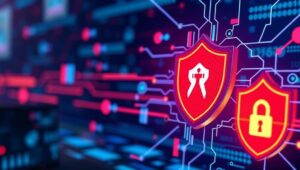AI for Threat Detection and Response: The 2025 Standard
In the rapidly evolving landscape of cybersecurity, Artificial Intelligence (AI) is no longer a futuristic concept but a present-day necessity. By 2025, AI-driven threat detection and response will be the standard for organizations aiming to maintain robust security postures. This article explores why AI is becoming indispensable, how it’s transforming cybersecurity, and what to expect in the coming years.
The Imperative of AI in Cybersecurity
The volume and sophistication of cyber threats are increasing exponentially. Traditional security measures often struggle to keep pace, leaving organizations vulnerable to attacks. AI offers a scalable and intelligent solution by:
- Automating Threat Detection: AI algorithms can analyze vast amounts of data in real-time to identify anomalies and potential threats that would otherwise go unnoticed.
- Enhancing Response Times: AI can automate incident response, significantly reducing the time it takes to contain and mitigate attacks.
- Improving Accuracy: Machine learning models continuously learn from new data, improving their ability to accurately detect and classify threats while minimizing false positives.
How AI is Transforming Cybersecurity
AI is revolutionizing various aspects of cybersecurity, providing enhanced capabilities and efficiencies.
1. Threat Intelligence
AI algorithms can aggregate and analyze threat intelligence from diverse sources, providing a comprehensive view of the threat landscape. This enables organizations to proactively identify and address potential threats before they can cause harm.
2. Anomaly Detection
AI excels at identifying deviations from normal behavior, which can indicate malicious activity. By continuously monitoring network traffic, user behavior, and system logs, AI can detect anomalies that traditional security tools might miss.
3. Automated Incident Response
AI can automate many of the tasks involved in incident response, such as isolating infected systems, blocking malicious traffic, and deploying security patches. This significantly reduces the time it takes to contain and remediate attacks.
4. Vulnerability Management
AI can assist in identifying and prioritizing vulnerabilities by analyzing code, network configurations, and system settings. This enables organizations to focus their efforts on addressing the most critical vulnerabilities first.
Looking Ahead: AI in Cybersecurity by 2025
By 2025, AI will be deeply integrated into cybersecurity operations, becoming the cornerstone of effective threat detection and response. Key trends to watch include:
- Increased Automation: AI will automate more complex tasks, such as threat hunting and forensic analysis, freeing up security professionals to focus on strategic initiatives.
- Enhanced Collaboration: AI will facilitate better collaboration between security teams by providing a common platform for sharing threat intelligence and coordinating response efforts.
- Improved Adaptability: AI models will continuously adapt to new threats and attack techniques, ensuring that security defenses remain effective over time.
Challenges and Considerations
While AI offers significant benefits, organizations must also address several challenges to successfully implement AI-driven cybersecurity. These include:
- Data Quality: AI models require high-quality data to perform effectively. Organizations must ensure that their data is accurate, complete, and properly labeled.
- Explainability: Some AI models, such as deep neural networks, can be difficult to interpret. Organizations should prioritize models that provide insights into their decision-making processes.
- Bias: AI models can be biased if they are trained on biased data. Organizations must carefully evaluate their data and algorithms to identify and mitigate potential biases.
Conclusion
AI is poised to revolutionize cybersecurity, offering unprecedented capabilities for threat detection and response. By 2025, AI will be the standard for organizations seeking to protect themselves from increasingly sophisticated cyber threats. Embracing AI in cybersecurity is not just an option but a necessity for maintaining a strong security posture in the digital age. As organizations move forward, addressing the challenges and considerations associated with AI will be crucial to unlocking its full potential and ensuring a safer cyber landscape.




